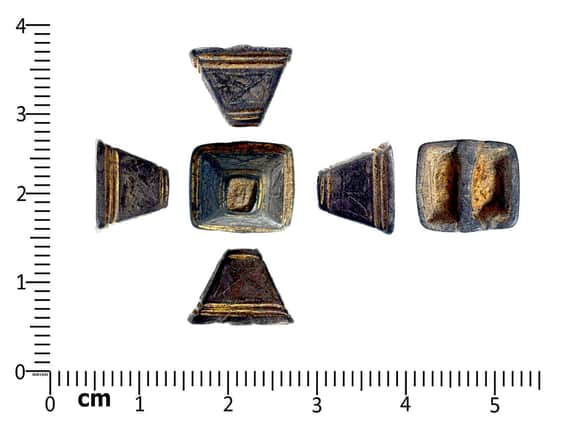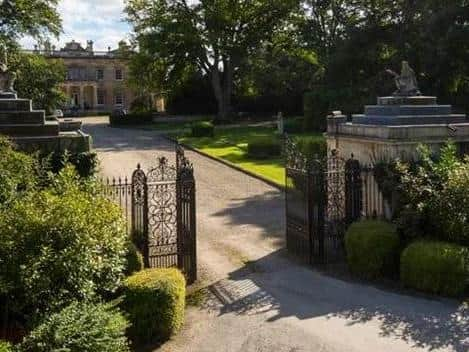Sixth-century sword scabbard mount found on Yorkshire estate is similar to treasure from Sutton Hoo dig


The find has added poignancy for Peter Spencer, from Horsforth, as it was made on his final outing with his detecting equipment before lockdown was announced last year.
Mr Spencer was given permission by the owners of an arable field on the Grimston Park estate, near Tadcaster, to search their land in February 2020.
Advertisement
Hide AdAdvertisement
Hide AdHe came across the 12mm cast silver mount from a sixth- or seventh-century sword scabbard - which would have been used to attach the weapon and its sheath to a man's clothing - and immediately recognised it as being Anglo-Saxon in origin.


At an inquest held at County Hall in Northallerton this week, coroner John Broadbridge officially 'rubber stamped' the item as treasure, meaning it will now be sent for expert valuation before being offered to museums for sale. York Museums Trust have already expressed interest in acquiring it.
Mr Spencer told the Yorkshire Post that the find is 'unusual' as the Grimston estate was not thought to have been a settlement in that period, with the nearest population centre being York.
He suspects that it was dropped accidentally by a passing warrior of high social status, possibly after the stitching on his clothing came apart.
Advertisement
Hide AdAdvertisement
Hide AdPreviously, the best examples of mounts of this kind were found among the treasure cache inside the Anglo-Saxon burial ship encased in a mound in Suffolk that was excavated in 1939. The discovery of the Sutton Hoo hoard is the subject of the recent Netflix film The Dig. In the Sutton Hoo case, the scabbards themselves had rotted away but the mounts remained.
Mr Spencer, a member of the West Riding Detector Group, has since been unable to go on detecting outings and has had to postpone several planned exploratory visits.
"After the Romans left, the ancient Britons were being troubled by piracy, so they hired Angles, Saxons and Jutes from Europe as mercenaries, and they decided to settle here themselves," he said.
"I recognised the mount immediately as being Anglo-Saxon, but I was mystified. We've been searching Grimston for 15 years and only found the odd bit that was Anglo-Saxon, and nothing else in that field. It was clearly from a high status man, who is likely to have been from a larger settlement and who dropped it when passing through.
Advertisement
Hide AdAdvertisement
Hide Ad"There is very little evidence of Anglo-Saxon settlement in the surrounding area, only of a little bit of activity. York would have been the nearest town."
Mr Spencer has been detecting since the 1990s and has learned that the best finds sometimes come from the unlikeliest of sites.
"I've been to sites near castles and abbeys that have yielded very little, and other places where I've wondered if it was even worth turning my machine on, but then they've turned out to have been part of important settlements."
It was the West Riding group, which has around 40 members, who found the Knaresborough hoard in 2008 - over 170 extremely rare coins from the era of King Henry I. Only two were bought by museums, and the rest were divided between the finders and the landowner.
Advertisement
Hide AdAdvertisement
Hide AdMr Spencer expects York Museums Trust to add the mount to their collection once it has been valued.
"You occasionally get museums who express interest but then say they can't afford it - they should really have some idea before it goes to that stage!
"York have a lot of good Anglo-Saxon stuff. They've also got the Vale of York hoard, which was found in 2007 and was worth about £1.8million, and the Middleham Jewel, which was vauled at £2.5million."
The government's Portable Antiquities Scheme, which has catalogued the find, said: "Pyramidal mounts are well known in Anglo-Saxon and Continental archaeological contexts. Their function is still uncertain, but it seems likely that they were used to help secure the sword in the scabbard, by means of a strap running through the transverse bar on the base. Two were famously found in the high-status graves of Sutton Hoo Mound 1, but they are relatively uncommon grave finds. They are, however, familiar as stray finds with ever-increasing numbers recorded on the PAS database."
Yorkshire's greatest amateur finds
Advertisement
Hide AdAdvertisement
Hide Ad- The Middleham Jewel is a 15th-century gold pendant that was found on a bridle path near Middleham Castle, the home of King Richard III, by metal detectorist Ted Seaton in 1985. As this was before the 1996 Treasure Act, finds could simply be declared as 'lost' if they did not have a clear owner and did not have to be offered to museums, so it was sold at auction at Sotheby's for £1.4million. However, an export licence was refused so that funds could be raised to purchase it for the nation instead. The York Museums Trust acquired it in 1992 for £2.5million, after a fundraising drive that included donations from millionaires the Richard III Foundation, North Yorkshire County Council and £20,000 from members of the public.
- The Vale of York hoard was uncovered in 2007 by Leeds father and son metal detectorists David and Andrew Whelan. They found over 600 silver coins from the Viking period that dated back to the 10th century - the most significant Viking hoard found since 1840. They were detecting in a field which was not thought to have been part of an ancient settlement.
- The Gilling sword from the Anglo-Saxon period was found by a nine-year-old boy called Gary Fridd in the Gilling Beck in the village of Gilling West in 1976, while he was looking for tadpoles. It was only 2ft from the edge of the bank, and had possibly been unearthed by mechanical digging in the area. Amazingly, it was not declared as treasure and became Gary's property - he appeared on Blue Peter to talk about it and was awarded a Blue Peter badge. It was later purchased at auction by the York Museums Trust in 1977.
- The Bedale hoard consisted of 48 silver and gold items from the ninth and 10th centuries including necklaces and a sword pommel. The trove was found in a field near Bedale in 2012 by metal detectorists, who reported the find. A public funding campaign enabled the York Museums Trust to purchase the hoard for £50,000.
Comment Guidelines
National World encourages reader discussion on our stories. User feedback, insights and back-and-forth exchanges add a rich layer of context to reporting. Please review our Community Guidelines before commenting.